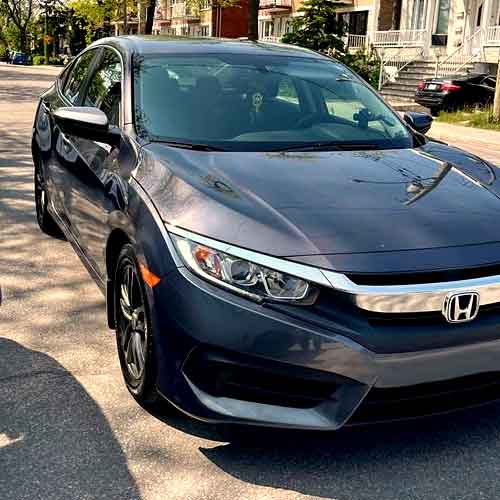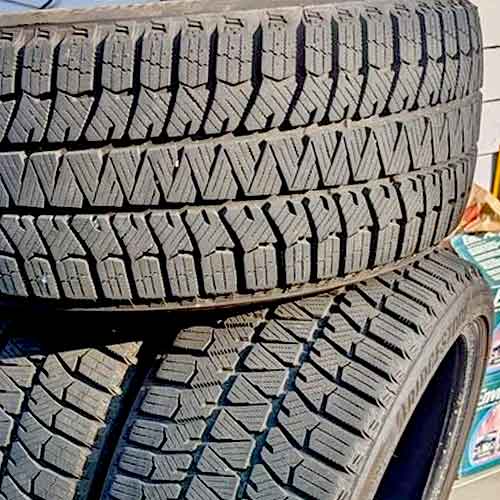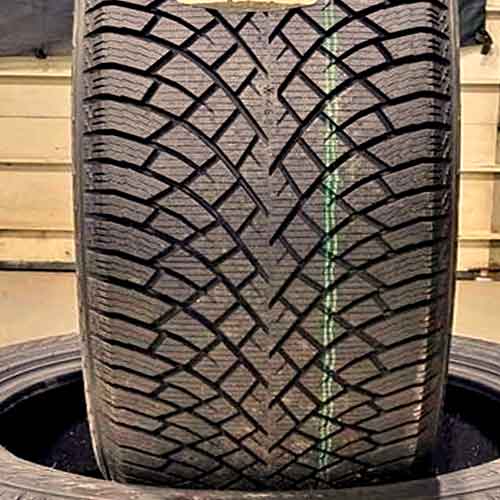Both the Bridgestone Blizzak WS90 and the Nokian Hakkapeliitta R5 are top-tier winter tires, each excelling in different areas and making a unique mark in terms of performance, efficiency, and comfort, thereby offering a wide range of options to meet varying user preferences and driving conditions. Let’s dive in to these tires in more details.

Table of Contents
Sizes Takeaway
The Bridgestone Blizzak WS90 (review) comes in 52 total sizes in 15 to 19 inches (wheels) with following specs.
- Speed ratings: T or H.
- Load ratings: SL or XL.
- Tread depth: 11 or 12/32″.
- Weight: 17 to 29 lbs.
- Tread warranty: None.
On the other side, the Nokian Hakkapeliitta R5 comes in 14 to 20 inches with following.
- Speed ratings: R and T.
- Load ratings: SL and XL.
- Tread depth: 11.5/32″
- Weight: 15 to 35 lbs.
Design Appearance
The Bridgestone Blizzak Ws90 commands attention with its sturdy and carefully devised directional tread pattern.

The Bridgestone Blizzak WS90
The tread features three distinct ribs, with the central rib crafted as a continuously running piece.
This rib is enriched with a variety of wave-like sipes, along with straight, interconnected incisions, effortlessly merged with in-groove notches.
And those notches further have V-shaped openings (on both lateral sides), adding to overall tire’s biting abilities.
Moving towards shoulders, they may seem to be divided by longitudinal slits, they are considered as notches (as they are full depth).
Besides these, you also lateral notches facing the middle too.
Other than this, these lugs get to have multiple-angles sipes of wave-like pattern.
And as they features widest of all lateral tread voids, they also account for superb self cleaning tread abilities.
On the other hand, Nokian Hakkapeliitta R5 features a totally different tread pattern, though its also directional.

In the middle most area, you can see a continuous rib, here as well (just like its competitor).
This rib is structured with multiple in-groove notches, and very aggressive/biting wave-like sipes.
The surrounding lugs, are blocky/squared-off, though they carry similar siping pattern. Though further out, lugs get to be more, you can say, lengthier.
So, because of this the shoulder blocks get to be the most elongated.
These lugs carry saw toothed edges on their both lateral sides as well, and their siping pattern is also slightly more thicker.
And, worth reminding, all of these lugs you see (including central ones), sit on a secondary rubber layers underneath, which act as reinforced foundations.
Tread Life
Tread life is determined by a combination of factors including the tire’s weight, tread depth, design, and compound composition. Given these variables, it becomes clear why the Bridgestone Blizzak WS90 outperforms in this aspect.
Firstly, the Blizzak WS90 is lighter, which means each of its lugs experiences less weight pressure, resulting in reduced friction as they engage with the road surface.
Additionally, the Blizzak WS90 boasts a slightly deeper tread depth. This is beneficial as the deeper the tread voids, the longer it will take for the tire to wear down to replacement levels.
On the other hand, while the Nokian Hakkapeliitta R5 benefits from a slightly firmer tread compound that resists wear, its overall tread life is still shorter when compared to the Blizzak WS90.
Comfort Levels
Ride comfort is essentially a combination of noise reduction and the tire’s capacity to absorb road shocks.
Talking about noise first, so this noise gets primarily produced when air particles strike the walls of the tread.
So to put simply, larger tread gaps tend to result in a noisier tire.
And so in this aspect, the Nokian Hakkapeliitta R5 gains an advantage with its more compact design.
Moreover, the tire features superior pitch sequencing technology, where variations in the tread block geometry allow for the creation of different tones by air particles. These tones subsequently cancel each other out, reducing noise.
On the other hand, the Bridgestone Blizzak WS90 excels in dampening vibrations, thanks to its softer overall tread compound. Its relatively softer tread composition enhances its ability to absorb shocks, ensuring a more comfortable ride.
So in essence, while the Blizzak WS90 offers better performance in terms of impact comfort, the Nokian Hakkapeliitta R5 provides a quieter ride, each excelling in their respective areas of comfort.
Fuel Usage
Fuel efficiency in tires is intrinsically related to tread design and structural weight, as these factors determine the rolling resistance, which in turn directly influences fuel consumption.
In this regard, both the Bridgestone Blizzak WS90 and Nokian Hakkapeliitta R5 exhibit similar levels of rolling resistance. While the Blizzak WS90 has a lighter overall structure (on average across all sizes), it features marginally wider tread voids which induce additional lug movement during maneuvering. This action necessitates extra fuel consumption.
However, this effect is balanced out by the Nokian Hakkapeliitta R5, which, despite its heavier weight exerting more force on the lugs, results in comparable levels of fuel consumption.
Thus, in terms of fuel economy, it’s a draw between the two tires.
Fluffy Snow Traction
On soft snowy terrains, the Nokian Hakkapeliitta R5 manages to edge forward a little bit. And it achieves this through its extensive array of gaps or biters that function as snow traps.
These snow traps promote a stronger snow-to-snow connection, which forms the tire’s contact patch with the ground, thereby increasing traction. This effect is due to the fact that snow adheres more effectively to itself than it does to rubber.
Further enhancing its performance is the tire’s streamlined and curvilinear tread pattern. This unique design generates a paddling effect, facilitating the scooping and ejecting of snow, which propels the vehicle forward.
In contrast, the Bridgestone Blizzak WS90 lacks these specific features.
Although its tread pattern is also directional, it lacks the streamline effect of the Hakkapeliitta R5, reducing its effectiveness in propelling snow backwards to create forward momentum.
Furthermore, upon closer examination of its tread, it becomes clear that it doesn’t have as many interconnected tread voids as its competitor, thus resulting in less efficient snow-to-snow contact.
So Nokain’s tire is overall better here, providing superior fluffy snow traction.
Dry Traction
Dry traction, a pivotal performance metric for any tire, depends on the amount of rubber making contact with the road surface. Here, two critical aspects come into play: directional grip and lateral traction.
Let me talk on them one by one.
Directional Grip
The efficiency of directional grip is mostly concentrated in the tread’s central area, given that the majority of the tire’s load is focused there, particularly when driving straight on highways.
This attribute explains why the Nokian Hakkapeliitta R5 outperforms in this area.
Although both tires have continuous central ribs ensuring consistent ground contact, the Hakkapeliitta R5 has a more enclosed pattern, even on the surrounding lugs, which contributes to an average braking distance reduction of 4 feet in tests compared to the Blizzak WS90.
Directional Grip is superior on Nokian Tire.
Handling
The quality of handling primarily relies on the tire’s shoulders and total weight.
During cornering, due to inertia, the weight is shifted to the tread’s edges.
Despite the Nokian Hakkapeliitta R5 featuring more closely packed shoulder voids, its higher weight becomes a disadvantage.
Its larger weight leads to increased lug movement when cornering, thus reducing steering feedback.
In contrast, the lighter Bridgestone Blizzak WS90 offers a more balanced relationship between understeering and oversteering, improving overall steering response.
So handling is better on Blizzak.
Ice Traction
When it comes to performance on icy terrains, the Bridgestone Blizzak WS90 reigns supreme, relatively speaking.
The tire incorporates innovative design elements, including specialized biters uniformly scattered across the tread and equipped with V-shaped notches.
And these, when combined with the array of siping angles, you get a tire with outstanding braking and acceleration capabilities on icy surfaces.
Moreover, worth reminding, the Blizzak WS90 tire’s comprehensive grip from all angles further adds to that.
In contrast, the Nokian Hakkapeliitta R5, despite having an ample number of in-groove notches, lacks an aggressive siping pattern.
The sipes, while interlocking, don’t accommodate as many biters and lack the various angles present on the Blizzak WS90. Consequently, its overall grip on ice is relatively compromised.
So overall, when confronted with icy conditions, the Bridgestone Blizzak WS90 indisputably comes out on top.
Wet Grip
Both tires, here, have ample siping and flexible tread rubber, so you get amazing directional grip with them.
In fact upon testing, you get to see that both tires come up with similar braking distances (calculated on average). So you get a similar grip on both.
Though in terms of handling, you get slightly better results with the Blizzak WS90.
The advantage in handling is primarily due to the Blizzak WS90’s superior water clearance abilities, attributed to multi-angled sipes and notches that face both lateral and longitudinal directions on its shoulders.
This design enables grip in all directions when cornering, reducing the risk of slippage.
Conversely, the Hakkapeliitta R5, which only has laterally oriented sipes on its shoulders, shows a deficiency in overall handling times during testing.
So overall, you can say, that Blizzak WS90 has the upper hand here.
Summing Up
So what did we learn here?
Well that each tire shines in different areas.
The Nokian Hakkapeliitta R5 excels on snowy terrain due to its extensive snow traps and streamlined tread design, providing superior snow traction. And you get better directional traction on this tire in both wet and dry roads.
Conversely, the Blizzak WS90 outperforms in icy conditions due to its specialized biters and comprehensive grip from multiple angles. And this tire features superior handling capabilities in both wet and dry.
In terms of treadwear, the Blizzak comes out better, offering longer tread life.
And fuel economy is almost similar on both.